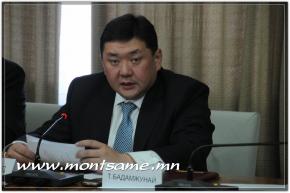ID :
99836
Wed, 01/13/2010 - 18:32
Auther :
Shortlink :
http://m.oananews.org//node/99836
The shortlink copeid
M.ENKHBOLD WORKS IN RCAG

Ulaanbaatar, /MONTSAME/ Deputy Premier and head of the State Emergency Commission M.Enkhbold visited Tuesday the Research Center of Astronomy and Geophysics at the Academy of Sciences (RCAG). He was accompanied by Ts.Enkhtuvshin, a Secretary of the National Security Council (NSC) and B.Baatarzorig, the First Deputy Mayor of Ulaanbaatar.
A moderate earthquake measuring 5.6 on the Richter scale jolted the central regions of Mongolia (Dundgobi province and Ulaanbaatar city) on January 9, 2010. The earthquake was felt by Ulaanbaatar residents and local people, but there was not any property damage or casualties. The RCAG is going to carry out a detailed seismological research because an earthquake is possible to take place again in Mongolia. Some 12 years ago an earthquake hit territory of Dundgobi aimag's Deren soum. This province suffered a damage of more than MNT 4 million, some buildings collapsed.
Ulaanbaatar city is located on active seismic zone, the researchers said. Since the year 2004, several earthquakes have shaken places located near the city such as Khustain nuruu national park, Emeelt, Olziit and Songino villages and "Chinges Khaan" international airport, they went on. "A frequency has been increasing and becoming active. We have proposed foreign countries to carry out researches into seismic levels and buildings earthquake resistance," the researchers said.
"It is possible to predict an earthquake one-two minutes beforehand. However too short this time is to survive from earthquake aftermath, we consider it as enough to prevent damages, especially if to train people."
The Deputy Premier said the government will spend money for earthquake aftermath prevention.
The RCAG has the latest facility of seismology estimating levels of seismic power and frequency and receives information about earthquake around the country within 10 minutes.
B.Khuder
15.39
A moderate earthquake measuring 5.6 on the Richter scale jolted the central regions of Mongolia (Dundgobi province and Ulaanbaatar city) on January 9, 2010. The earthquake was felt by Ulaanbaatar residents and local people, but there was not any property damage or casualties. The RCAG is going to carry out a detailed seismological research because an earthquake is possible to take place again in Mongolia. Some 12 years ago an earthquake hit territory of Dundgobi aimag's Deren soum. This province suffered a damage of more than MNT 4 million, some buildings collapsed.
Ulaanbaatar city is located on active seismic zone, the researchers said. Since the year 2004, several earthquakes have shaken places located near the city such as Khustain nuruu national park, Emeelt, Olziit and Songino villages and "Chinges Khaan" international airport, they went on. "A frequency has been increasing and becoming active. We have proposed foreign countries to carry out researches into seismic levels and buildings earthquake resistance," the researchers said.
"It is possible to predict an earthquake one-two minutes beforehand. However too short this time is to survive from earthquake aftermath, we consider it as enough to prevent damages, especially if to train people."
The Deputy Premier said the government will spend money for earthquake aftermath prevention.
The RCAG has the latest facility of seismology estimating levels of seismic power and frequency and receives information about earthquake around the country within 10 minutes.
B.Khuder
15.39





